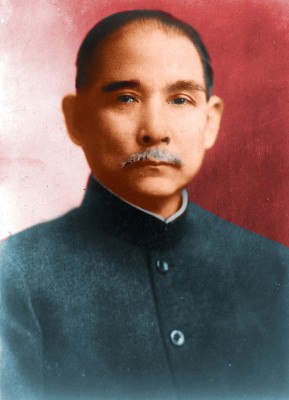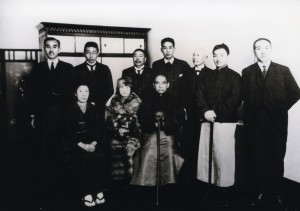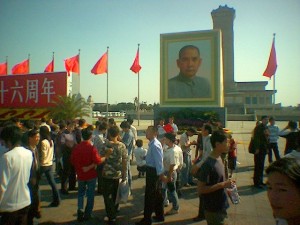Sun Yat-sen (1866-1925) was the founder of the Kuomintang, a revolutionary group in China that ousted the Manchu or Qing dynasty from China and set up the Chinese Republic.
Early Life
Sun was born into a peasant family in a village near the Canton (Guangdong) Province just after the Taiping uprising, which was a great civil war that sought to oust the Manchus and was, in the end, savagely put down by them. Sun grew up listening to the men around him who often spoke about their fight against the oppressive and corrupt Manchu dynasty. His worldview was widened when emigrant members of his family, including Sun Mei, his older brother, arranged for him to attend school in Honolulu and then in Hong Kong. These experiences spoke to Sun of the better life available in the West. He resolved to become a doctor and first studied at the Canton Medical College, which was run by Americans, and then at Hong Kong University. Both schools were filled with teachers and students passionately discussing the rising tide of European socialism and democracy.
Revolution
Filled with this new way of thinking, Sun soon became a leader. The Chinese who lived overseas supported him and he used their money to travel to Japan, the United States, Canada and Europe and write to every country where other Chinese were studying. In this way, scores of graduate students that returned to China to start their professions or enter military or civil service were influenced by Sun’s ideas. He also became known among the powerful of many countries in the West. He did this for the better part of 20 years. This is how his revolutionary group, the Kuomintang, was born.
By 1911, the revolutionaries who had studied abroad were strong enough to attempt to overthrow the Manchus. Ironically, Sun was not in the country when the revolution happened, but was lecturing in Denver, Colorado. It was there that he heard that part of the Hankow Garrison had risen up against the Manchus. Sun was not the only one surprised by the uprising. The United States’ President Taft had just loaned the Manchu government a great deal of money with the belief that it was durable. The revolt began as a protest against this loan and those feelings spread throughout the country.
Another thing that helped Sun’s revolution was the fact that the new Manchu Emperor was a baby and the Dowager Empress, who would have been in ruthless control, was dead. The revolutionary army felt free to demand that the imperial family abdicate, which they did. Sun went to London to ask the British government not to interfere in the revolution and to prevent the Japanese from interfering. In another irony, the dynasty that had been nurtured for years by the West was now defeated by western ideals.
The reaction of the United States was mixed. She welcomed Sun as a democrat, but she had been supporting the dynasty and was also uneasy.
Sun rushed home to China and his followers proclaimed him President at Nanking. However, the revolution was fairly shallow. Besides men everywhere cutting off their queues, which had been imposed by the Manchus, nothing much changed in Chinese life. Sun’s power rested mostly in the southern and central provinces, while Peking (now Beijing) and the central government were controlled by Yuan Shih-k’ai, one of the Manchus’ generals. Yuan, a man who knew how to take advantage of situations he could not control, told Sun that he could keep his revolution if he, Yuan, became president. He still had his army and foreigners supporting him. Sun resigned his presidency and withdrew to Canton.
World War I
World War I broke out soon after this. The European powers were preoccupied and Yuan declared himself Emperor. Though the Chinese seemed indifferent to the revolution, they were not so indifferent as to want another dynasty so soon after the last one so they revolted. Yuan’s army was defeated, and he was soon dead. Though there was an attempt at imperial restoration in 1917 with Pu Yi, the child emperor, the Chinese rejected this as well.
Following World War I, China was essentially adrift. Each province seemed to be ruled by a warlord. China’s industrialists, who were suffering in the chaos, began to look more and more to Sun Yat Sen and his Kuomintang, who were still in Canton. Sun believed that the technically more advanced West could not only invest in China, but also help her set up a stable, democratic government. He believed that the situation would be beneficial to both China and the West. But, the United States and Britain did not trust him and rejected his offers.
The rejection of Sun by the United States and Britain caused Sun to turn to the newly born Soviet Union, who was willing to treat the Chinese as an equal. As the Soviets were just emerging from the Great War, they had no money but yet sent advisers to China. It was with Russia’s advice that the Kuomintang was changed into a coalition of like-minded revolutionaries who believed in freedom. The Chinese Communists were also admitted and political outreach was given to Chinese peasants.
Principles and Policies
Sun Yat Sen died in 1925. But before that, he left the Kuomintang the Three People’s Principles, a set of Three Great Policies and a Will. The Three Principles were national independence, democracy and improvement of the people’s livelihood. The Three Policies were anti-imperialism, cooperation with the Soviet Union, and encouragement of the workers’ and peasants movements. His will set up a plan for National Reconstruction which would set up a government that provided the four basic needs of the people of China for food, clothing, housing and transportation.
The First National Convention, held in 1924, had the Three People’s Principles and the Three Great Policies as its platform and provided terms of cooperation between the Communists and the Kuomintang.
Personal Life
Sun Yat Sen was baptized a Christian in Hong Kong. In October of 1915, he married Soong Ching-Ling, who was the daughter of Charles Soong, who himself was a minister in the Methodist denomination. The marriage made Sun the brother-in-law of his protégé, Chiang Kai-shek, who married Ching-Ling’s sister after Sun’s death.


